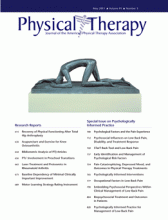The purpose of this special issue of PTJ is to present and integrate research evidence about the influence of psychosocial factors on presentation of symptoms of pain and disability (function) in physical therapist practice. We have focused primarily on low back pain, as it is the most widely researched musculoskeletal condition. We have included a number of perspective articles, specifically elicited from established researchers, but we also have taken the opportunity to include several empirical studies that have been submitted independently to PTJ. These empirical studies have allowed us to illustrate (and hopefully illuminate) facets of the overall conceptual framework presented in this special issue.
As guest editors, we were at times fairly specific in the requests and recommendations we made to our colleagues, in terms of breath of topic, depth of analysis, and overall style of presentation. We attempted the difficult task of developing articles that are able to “stand alone” but that also can be viewed as complementary parts of this special issue. We have retained the considered opinion of the authors while also trying to accommodate the issues raised by our external peer reviewers as part of the normal review process. As a precursor to the articles included in this issue, we briefly offer a number of reflections on why we embarked on this endeavor.
Current Education and Practice Model for Physical Therapists
We offer an initial theoretical framework (Figure) that sets the context of this special issue. In the Figure, management of low back pain is depicted as a continuum of physical and psychosocial factors, with varying amounts of each. At one extreme of this continuum, the primary influences on symptom presentation are physical factors, and, at the other extreme of the continuum, the primary influences are psychosocial factors. These extremes are matched with the corresponding patient management model in the Figure …












